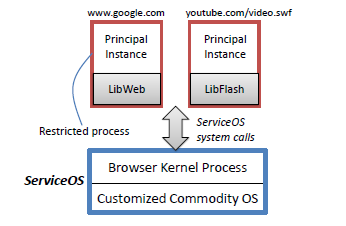ServiceOS: Microsoft's morphing browser-operating system project

It's been a while since Microsoft shared publicly anything new about its "Gazelle" browser research project.

In checking up on Gazelle, I discovered a few interesting new tidbits. For one, Gazelle (formerly known as MashupOS) has morphed again and is now part of a research project known as ServiceOS. The focus of Gazelle was on security/protection; ServiceOS fleshout out the vision for what resource access and management would like like for Web applications. Two of the Microsoft researchers behind the project -- Helen Wang and Alex Moschuk --published late last year a white paper explaining the evolution of their new ServiceOS vision.
From an introduction to that paper: "Existing browsers rely on resource access control and sharing mechanisms built into traditional OSes. Unfortunately, such mechanisms are ill-suited for many complex web services, such as those embedding mashups of other web services."
Sounds like Google's premise with Chrome OS, right? Traditional OSes are unwieldy when it comes to running Web apps/services and are no longer needed?
Well, not exactly.
The ServiceOS platform "tightly integrates a multi-principal browsing architecture with the underlying OS," the authors explain. That means resource-access control and the sharing of system resources is built into the platform. The platform also includes "new abstractions that allow a web service to explicitly allocate and manage resources for any helper services they embed," they add.
The researchers have built a ServiceOS prototype that manages "a wide range of resources, including CPU, memory, network bandwidth, and devices like cameras microphones, or GPS." (It doesn't seem like the prototype is publicly available at this point.)
As always, it's worth noting that Microsoft Research projects may take years to become commercialized products and/or components of commercialized products (if they ever do). So it's not a good assumption to think ServiceOS will be part of IE 9 or Windows 8. But it is interesting that Microsoft is continuing to forge ahead with this concept....